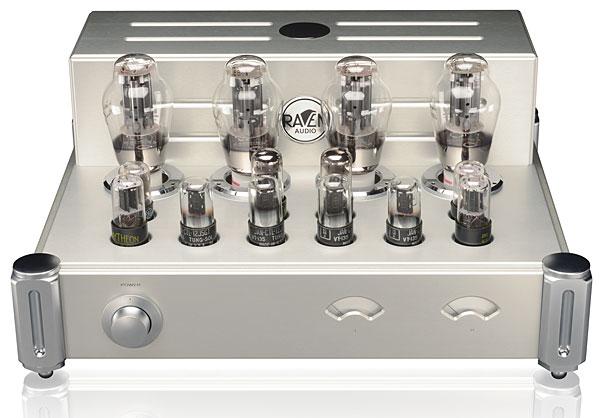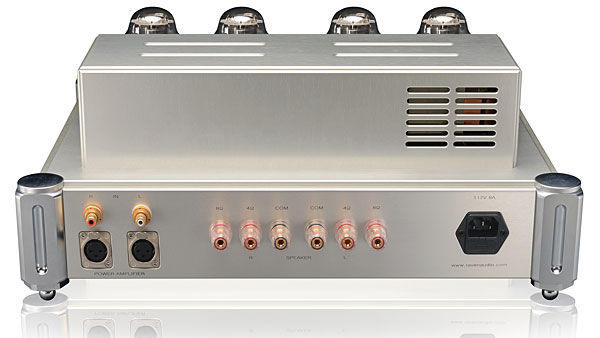| Columns Retired Columns & Blogs |
Editor,
would the description or the plots on the figures 2 and 3 changed from one to each other?

And then this primitive tube, this plaything of fevered crazies who would drag us all back to a hellish world of handmade electronics and efficient loudspeakers, did the unexpected: The 300B went mainstream. Now, with each passing year, shoppers in the perfectionist-audio marketplace are offered ever greater numbers of 300B power amplifiers, at ever more widely diverging prices. Not bad for a 76-year-old electronic device (footnote 1).
Amplifiers designed in the West and built in the East account for much of that bounty, so I was intrigued by the offer of a review sample of the opposite: a 300B amplifier designed in Korea and built in the archetypally American state of Texas. The Spirit 300B Reference Stereo amplifier, designed by S.E. Han and built by Dave Thomson of Raven Audio, came my way in January, and has made an indelible impression.
Preparation
But it didn't happen just like that.
This review began with a different Raven amp: the Spirit 300B Reference Monoblock—two of them, in fact. They arrived in ostensibly fine shape, but when I installed them in my system, something happened that I had not, in 30 years of writing about hi-fi gear, experienced before: After powering them up and waiting about 20 seconds, during which I heard intermittent buzzes and hums from at least one channel, I first saw and then smelled acrid smoke rising from the amps. (The amps were both on the hardwood floor, quite close to each other, so I can't say for sure if the smoke was coming from both, though I believe that it was.) I quickly powered-down the Ravens and disconnected their AC cords, then rushed outside for fresh air.
A smoking amplifier is, it seems, an invitation to self-doubt—a feeling I dispatched with a few basic checks. Yes, the Spirits were indeed marked for 117 VAC operation. Yes, although neither amp was accompanied by an owner's manual—toward the end of the review period, I received, as a pdf, a manual for the Raven Spirit—I had correctly followed the tube-installation chart sent to me by Raven's publicist, in response to my request for same.
There followed, as one might expect, strings of e-mails between me, Raven Audio, their publicist, and editor John Atkinson. Stereophile's policy requires that a product review, once begun, be carried to its conclusion, come what may: In the event of product failure, the reviewer is directed to request another sample. I did so, and was informed that the most recent production run of monoblocks had been sold out—and that restocking would not be soon in coming. I was then offered the chance to review the stereo version of the very same amp. (I was also told that I would eventually receive a postmortem on the departed Spirits, so that I can report on the cause of death, footnote 2) Because I'd already invested some time and effort in this project, and because it had become part of our editorial planning for this issue, the sideways step to a different model was approved. And so . . .
Description
The Raven Spirit 300B Reference Stereo amplifier, referred to henceforth as the Raven Spirit, is distinct from most modern 300B amplifiers in a couple of ways. First and most notably, while the 300B triode output tube is usually seen in single-ended amplifiers, designer S.E. Han has opted for push-pull design, with two 300Bs per channel and a reported output power of 28Wpc (according to the owner's manual) or 36Wpc (according to the Raven Audio website). Second, in contrast to the simple, pared-down designs of most contemporary 300B amps, the signal path of the Raven Spirit contains no fewer than five small-signal tubes per channel: two 12J5 dual-triodes, for voltage gain and phase inversion; and three 12SN7 dual triodes, acting as drivers, cathode followers, and as part of what is described as the amplifier's auto-bias system.
The Spirit's driver tubes are coupled to the output tubes by means of Hammond interstage transformers, and the output section appears to use a certain amount of negative feedback. Unlike the six small-signal tubes, which are all heated with DC, the 300B triodes are heated with AC from dedicated secondaries on the mains transformer; those windings are center-tapped, and a balance potentiometer has been added for each channel to help knock down hum. All rectification is solid-state.
The front panel of the Raven Spirit is home to a pleasantly chunky rotary power switch, and a pair of output-power meters. The rear panel contains an IEC socket for the AC cord (not included), speaker connectors with separate hot terminals for 4- and 8-ohm loads, and two pairs of input jacks: one RCA, one XLR. The owner's manual describes the latter as balanced, but a glimpse inside shows that they are merely wired in-line with the single-ended RCAs. (Pin 2 of each XLR is hot, with pins 1 and 3 both at ground.)

Inasmuch as the various casework components and their fasteners fit together precisely, the Raven's construction quality is quite good. The 64-lb chassis is tanklike—perhaps more so than is necessary, and certainly more so than is healthy for one's lower back—and is bolted together from well-machined chunks of aluminum and, according to Raven, bronze and brass (the latter presumably plated or anodized, as all surfaces were finished in a rainbow of silvers). Inside, parts quality is good, with some premium capacitors—MultiCaps and V-Caps—and what appear to be very good tantalum resistors throughout. Small-signal tubes are all apparently new-old stock from General Electric, RCA, and Tung-Sol. Wiring is neat and sensible, and the solder joins appear solid and extremely well made.
Installation and setup
The Raven Spirit Stereo arrived in a carton similar to those used for Raven Spirit Monoblocks; packaging was spare but effective, and all tubes arrived undamaged. That said, the Spirit arrived with two pairs of Russian-made Gold Lion output tubes (the same as the ones used in the Shindo D'Yquem amplifiers; see Stereophile, March 2014), but a day or two later I received, in a separate shipment, two pairs of the somewhat more expensive Sophia Electric Royal Princess 300B, which Dave Thomson of Raven Audio described in an e-mail as "the standard tube for the amp." I based my listening on the Sophias.
Footnote 2: The two amps that failed were serial nos. SPRMA-05-01-12-00001 and SPRMA-05-01-12-00002. See the "Manufacturer's Comment," appended to the end of this review.

Editor,
would the description or the plots on the figures 2 and 3 changed from one to each other?

i am the proud owner of raven audio amplification. "THE RAVEN" a 3oob tube based integrated amplifier. There can be no better amplification in the world. You see right thru the music. Your are drawn into it. All the details of the recording are there.Is there colorization by the tubes? Not sure.i can only tell you the music sounds exactly as intended and as natural and neutral as can be.it is rated at 15 watts per channel..Some may not understand. Raven audios 10 watts,is another tube companies 40 watts and solid states 80 watts. It is in the power supply and voltage regulation that all the power of god on earth is unleashed. the power is more than enough to fill my 20x 20 room with blasting clear,warm glorious sound. i have owned mcintosh,krell ,NAD AND MARK LEVINSON. There really isnt anything but maybe my old mac that sounds even close to the raven. andy rothman sharethemusic@aol.com